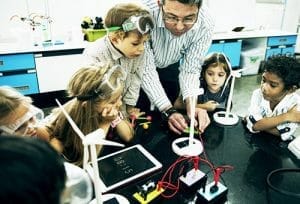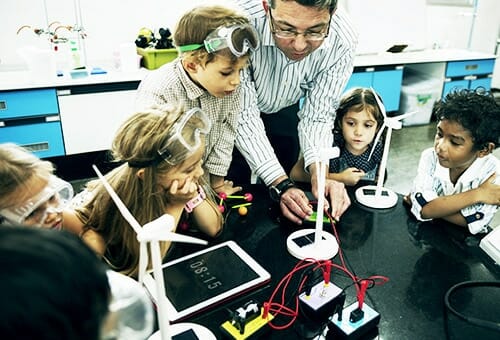Project-Based Learning is Closing the Gap Between Schools and the Real World.
source: study conducted by C.M. Rubin
According to many experts, school must be more relevant if kids are to thrive in the fourth industrial revolution, and research indicates that students exposed to project-based learning (PBL) are making significantly greater academic gains than students taught with traditional approaches. As students gain deeper knowledge about their work via PBL, they also learn real-world skills that will be invaluable to them for the rest of their lives. Thanks to real-world challenges such as the United Nations’ SDG’s, project-based learning is currently enjoying a revival. In this style of learning, students must address a problem that’s impacting their local or global community. The PBL process teaches students how to organize and present their thinking in a limited amount of time. Students have to collaborate with other classmates to find solutions and then present their findings to a group. All the skills involved in the work are critical for today’s world. C. M. Rubin, Founder of CMRubinWorld, asked top global teachers to share their examples of high-quality PBL programs. Educator Marjo Rantanen in Finland describes an EU program in which students improved their “entrepreneurial skills” and learned to “evaluate peer work and teamwork results.” Prerna Kumar in India explains her students worked longer and harder and described their experience as “joyful, authentic, powerful and resourceful.” Koen Timmers, who currently has students across 6 continents researching and brainstorming 4 climate change challenges, notes: “I believe in changing people’s mindsets via education.”

What does a high quality, global PBL program look like in your classroom?
By Prerna Kumar, Social Science faculty, Kulachi Hansraj Model School, Delhi
Project based learning is a non-conventional education model that seeks to prepare students for solving real-world problems and issues while teaching them what they need to know to succeed in school life and real life. Project based learning structures curriculum around concrete projects presented by students in pairs or groups. Such projects often force students to use multiple learning techniques to succeed, including research, logical deduction, and work with community. Since these projects are usually too large and complex for one student to do alone, project based learning also tends to encourage communication and collaboration. If students learn to take responsibility for their own learning, they will find a way to work with others in their adult lives and be prepared for the future.
Project-based learning (PBL) is a student centric approach that provides students with opportunities to participate collaboratively in groups in real-life opportunities where they are engaged in constructing learning that is personally meaningful.
Project Based Learning in the contemporary world is the essence for students’ life. This learning is experiential and helps students and teacher have multiple assessment opportunities. PBL aims to:
- Help the children to demonstrate their capabilities and potential while working independently and cooperatively.
- Display the child’s ability to apply required skills in real life.
- Develop the child’s ability to work with his/her peers, building teamwork, leadership, and collaboration skills.
To effectively implement the approach in the classroom, as educators we should first develop interest and motivate and engage our students. Teachers can accomplish this by allowing students to provide input on their learning experiences. When educators begin providing voice and choice to studentsit brings learning to life. Teachers need to personalize each student’s level of voice and choice based on how they learn. Individual teachers use PBL to deliver content, including content aligned to new, rigorous standards, and projects integrating this learning strategy can come in all shapes and sizes; some projects are interdisciplinary based on integrated learning while others focus on a single discipline. PBL can be used by integrating digital technologies improves the PBL methodology and in results. An educator serves here as a facilitator overseeing how students will shape their learning experiences, what path they will take, and how they will demonstrate that learning.
One major myth of student engagement is that it is chaotic and loose on discipline. But interesting and creative projects engage students also enhance their understanding. Even challenging and rigorous assignments are often more motivating for students. As educators, we often experienced times when we were appropriately challenged; we lost track of time, we researched more deeply, and we learned. Educators who also want to learn should seek to assign challenging projects to our students.
Many different interactions and situations need to be planned and facilitated by the teacher. As a Social Science teacher, I purposefully engage my students in all aspects of their enquiry by enabling them to ask questions along with reflecting on their own work. The focus of PBL is their individual growth. Students were involved in a community project “ME TO WE”.It‘s intention was to maintain an open system of inter-relationship with the surrounding communities. The students were given adequate time and clear instruction. Students had to use multiple approaches in their projects and cultivate a balanced approach to initiate and complete their project. PBL engrains essential problem-solving techniques to ensure students reach their desired goal. I believe in connecting academic situations to the real world. This is one of the largest benefits of project-based learning. PBL effectively addresses issues related to poor student engagement and motivation as it provides opportunities for learners to learn deeply. The theme of excitement is evident in all the observations.
Moreover, the students described their experience with PBL in their classes using strong adjectives such as ‘amazing’, ‘joyful’, ‘authentic’, and ‘powerful’ and ‘resourceful’ that stays on for lifelong learning. It helped our students give and receive constructive peer feedback. In the process of completing their projects, students also sharpen their organizational and research skills, develop better communication with their peers and adults, and often work within their society while seeing the positive effect of their work. The Project energizes the curriculum with a real-world relevance and sparking students’ desire to explore, investigate, and understand their world. The overall project aimed at documenting the implementation of PBL in the school through the eyes of the participating teachers.
PBL has been eagerly adopted by growing number of schools to enhance student motivation. It then, not only aims to equip students with content knowledge, but the ability to transfer learning across different contexts. It is widely considered to be an innovative instructional tool that has been implemented across a wide range of disciplines in tertiary settings.
The PBL approach has made me far more aware of my own mindset. I’ve always been a reflective person and creative person and I believe PBL has magnified that reflection and has given me the tools to further analyze the results of such learning. PBL has allowed me toexplore a number of possibilities. In brief, it keeps me on a hunt for new ideas. Professionally, this approach in my classroom has added the spark to incorporate all of my favourite aspects into our curriculum. I would advise and prefer my contemporaries to make an effort to find connections between the curriculum and personal passions.
Read the full article here
CMRubinWorld’s award-winning series, The Global Search for Education, brings together distinguished thought leaders in education and innovation from around the world to explore the key learning issues faced by most nations. The series has become a highly visible platform for global discourse on 21st-century learning, offering a diverse range of innovative ideas which are presented by the series founder, C. M. Rubin, together with the world’s leading thinkers.
For more information on CMRubinWorld
Follow @CMRubinWorld on Twitter
“ If you want to teach people a new way of thinking, don’t bother trying to teach them. Instead, give them a tool, the use of which will lead to new ways of thinking.”― Buckminster Fuller |

